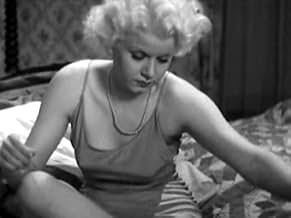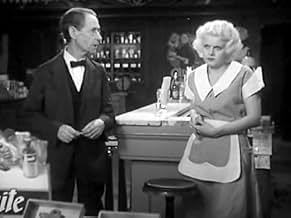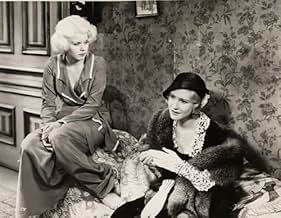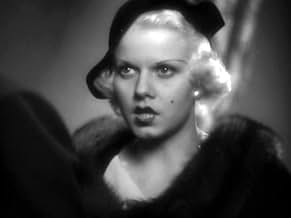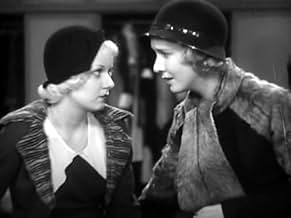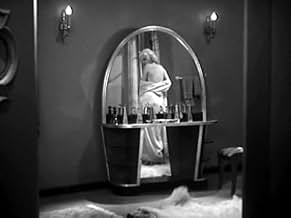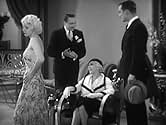Ajouter une intrigue dans votre langueCassie moves to New York and jumps from one job to another until she lands a modeling gig.Cassie moves to New York and jumps from one job to another until she lands a modeling gig.Cassie moves to New York and jumps from one job to another until she lands a modeling gig.
- Réalisation
- Scénario
- Casting principal
- Mrs. Kane
- (as Clare Ward)
Avis à la une
Jean stars as Cassie, a virtuous small town girl who supports her mother on her salary as a soda jerk. Mom is proud of her daughter but can't help but be a little envious of her friend whose daughter Mae Clarke sends home big bucks from New York. When the whole town notices the automobile Mae's mom gets, Jean decides check out the big city herself. Reunited with her friend Mae, Jean is still very much a small town innocent ("I think she still believes in Santa Claus", a warm, amused Mae quips to her beau) but soon learns about the perils of metropolitan life for a sexy young woman as she is pursued by wealthy Walter Byron who isn't quite divorced from his chic socialite wife Natalie Moorhead , and well as having to fend off advances from the married man Mae is supported by. A regretful Mae advises Jean not to take "the easiest way" to financial comfort but Jean's plump, work weary roommate Marie Prevost tells her to go for it.
As you might presume by my IMDb moniker, I can hardly be unbiased about Jean Harlow but I am rather level-headed and I think she was a sensational screen personality and an quite an excellent movie actress and this little picture shows she could deliver the goods even before the big MGM buildup later that year. For a young woman who was hotly publicized as the most erotic sex siren on the screen, she is totally credible and believable as this good girl who does not want to give in to immorality. Jean is outstanding. Mae Clarke has a unusually glamorous role for her as the chic model who couldn't quite be so pure and is is equally excellent in a sympathetic part as an intelligent young woman who made bad decisions. Marie Prevost, once a silent movie glamour girl, plays the character part of the wisecracking man-hungry plump and plain girl of the type that would later be a Patsy Kelly specialty. The two male leads are acceptable albeit totally locked into the era with their oiled-up hair and pencil mustaches although Walter Byron is rather appealing as Jean's married man, a good guy who lives to regret his abandoned marriage to Natalie Moorhead. Moorhead is always a treat to see in early talkies where she was typecast as a wealthy, often amoral, clotheshorse, her part in this movie is quite small but she's still good.
The title THREE WISE GIRLS is perhaps deliberately ironic as only one of our heroines truly has her head on straight but all three actresses shine in this film, most especially the beautiful and bewitching iconic film legend Jean Harlow.
The idea of a girl dating a married man is something you just wouldn't have seen two years later--after the Production Code was strengthened and eliminated plot elements such as adultery, premarital sex or extreme violence (among others). However, despite the film trying to justify Harlow's dating a married man, the film is not nearly as salacious as some of the more notorious Pre-Code films, such as Harlow's RED-HEADED WOMAN--a film you just need to see to believe.
Overall, this is a pretty good little film despite the less than stellar and inconsistent message about morality that the film delivers. Good acting, a decent story and enough twists and turns to keep it interesting make this a good Pre-Code film.
By the way, the other "wise girl" is Marie Prevost who was included mostly for comic relief. Also, if you really care, Chillocothe is a small town in rural southern Ohio. It's best known today as a town with prisons!
While Prevost seems to have a really good deal working at home sending out letters with advertisements for various companies both Harlow and Clarke get themselves involved with married men, for one of them it turns out really bad. Prevost seems to have the right idea.
Playing opposite Harlow is Walter Byron who had a run of minor popularity in silent films, but whose career gradually petered out in sound films. He sounds like George Brent in his speech pattern and voice, but looks like Charley Chase. I'm betting that's why he didn't succeed in sound.
This film was filled with tragedy with both Harlow and Prevost dying way too young within six years. Three Wise Girls is far from the best work of these fatally star crossed actresses.
Of the THREE WISE GIRLS, the story introduces Cassie Barnes (Jean Harlow), a small town girl living at home with her mother (Lucy Beaumont) and earning a living as a soda jerker for Lem (Robert Dudley) at the Chillicoale Drug Store. Finding that her good friend, Gladys Kane, has found success away from the town they grew up in, Cassie decides to follow suit by quitting her job and moving to New York City. Sharing an place with Dot (Marie Prevost), who supports herself addressing envelopes in their apartment, Cassie, soon meets Jerry Wilson (Walter Byron), a drunken millionaire, at the drug store. After quitting her third soda jerking job since moving to the city, Jerry, in good faith, takes Cassie home in his limousine. Later, Cassie comes to meet with Gladys (Mae Clarke), whom she hasn't seen in three years, at her place of work. Learning of her unemployment situation, Gladys arranges her employer, Andre (Armand Kaliz) to use Cassie as one of the models at $60 a week. As Cassie becomes romantically involved with Jerry, her situation soon patterns that of Gladys' courtship with Arthur Phelps (Jameson Thomas), a rich banker with eyes on Cassie, while Dot takes an interest in Jerry's chauffeur, Barney Callahan (Andy Devine). Complications soon take its toll for one of the "three wise girls."
Brief (67 minutes), and to the point, THREE WISE GIRLS limits itself of character introduction and plot development by presenting what it needs to be addressed without any drawn-out scenes. For Jean Harlow's first starring role, she's not bad. Her acting technique would improve greatly following her move to Metro-Goldwyn-Mayer, the studio where all her future films were made, with comedy being her finest contribution to the motion picture industry. Harlow's Cassie is sometimes sassy, but mostly on the serious side. She's unlucky when it comes to men as evidenced in the opening scene that has her walking home alone from a date she abandoned some miles down the road. She later loses her jobs due to some overly aggressive bosses. Regardless of setbacks, Cassie will not give up her dream to make it on her own. As for the co-stars, Mae Clarke, the secondary character living in a luxurious penthouse, comes off best with her natural flare of acting, with advise of not ending up "behind the eight ball"; while Marie Prevost, the third "wise girl," with little to do except being the funny member of the trio with the most common sense. Andy Devine, the one in chauffeur's uniform, is almost unrecognizable here, speaking only a few lines of dialog, none which have that recognizable trademark raspy voice for which he's known. Walter Byron, sometimes classified by film historians as a poor man's "Ronald Colman," does satisfactory work as a millionaire with his distrust for women, but would drift to uncredited parts by the end of the decade. Others in the cast include Natalie Moorehead (Rita Wilson), Katharine Clare Ward (Mrs. Kane), and Marcia Harris as the no-nonsense landlady.
With the exception of sporadic reissues in revival movie houses in New York City during the 1970s and 80s, THREE WISE GIRLS remains a seldom seen Harlow product. Though this time filler made its way on cable television's Turner Classic Movies July 10, 2009, one can only hope for revivals of other extremely rare Harlow finds as THE Saturday NIGHT KID (Paramount, 1929), GOLDIE (Fox, 1931) and THE IRON MAN (Universal, 1931) to become part of a television broadcast package. (**)
Le saviez-vous
- AnecdotesThis was the last film for which Jean Harlow was loaned out. All her remaining pictures were for her home studio, MGM.
- GaffesThe foam in Jerry's double Bromo-Seltzer goes down to the bottom of the glass in one shot, then it is back near the top of the glass when he finally goes to drink it.
- Citations
Dot: You know, addressing envelopes ain't as tough as it's cracked up to be.
Cassie Barnes: No?
Dot: No! There's a lot of money in it. I doped the whole thing out a while ago. At a dollar and a half a thousand, if I sell an envelope to everybody in the United States, I'd make a hundred and fifty thousand dollars!
Cassie Barnes: That's swell. Have you figured out how long it's going to take you to do that?
Dot: Oh, um... About two-hundred and fifty years.
Cassie Barnes: I had no idea there was such a future in it.
Meilleurs choix
- How long is Three Wise Girls?Alimenté par Alexa
Détails
- Durée1 heure 8 minutes
- Couleur
Contribuer à cette page


